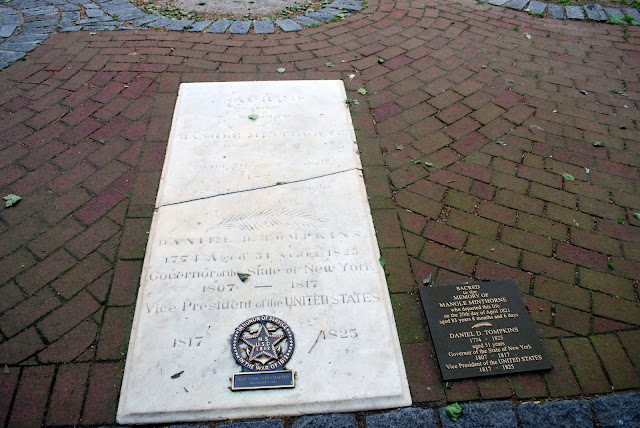I read this fascinating historical book recently about an almost forgotten period in American history, called "The Island at the Center of the World." It is about the Dutch colony of New Netherlands that was located on the east coast of North America in the seventeenth century for over fifty years, until the English gained control of it in 1664, and turned its capital, New Amsterdam, into New York City. Journalist and historian Russell Shorto was inspired to write this book when he learned about the New Netherlands Project which is based at the New York State Library in Albany, New York. For the last 30 years historian and linguistic scholar, Charles Gehring, has been translating 400 year old documents from New Amsterdam that were stored in the library for the project, and Shorto then interpreted them into a enthralling tale of the beginnings of the greatest city in the world.
Inspired by this book, I went out to find a little bit of the Dutch history that I read about, and I took a trip into the East Village/Lower East side neighborhood of Manhattan to visit Saint Mark's Church in-the-Bowery, located at 131 East 10th Street, at the intersection of 10th and Stuyvesant Streets and 2nd Avenue. It is located on the oldest site of continuous worship in New York City and it is the second oldest church in Manhattan.
The church history from it web site states: "The St. Mark’s Church and its yards are just a few reminders of the once vast “bouwerie,” or Dutch plantation, which Peter Stuyvesant, governor of New Amsterdam purchased in 1651 from the Dutch West India Company. When Stuyvesant died in 1672, his body was interred in a vault under the family chapel he’d had built in 1660. In 1793, Stuyvesant’s great-grandson, Petrus Stuyvesant, donated the chapel property to the Episcopal Church with the stipulation that a new chapel be erected and on April 25, 1795, the cornerstone of St. Mark’s Church in-the-Bowery was laid."
The site is officially listed on the National Register of Historic Places and was designated a New York City Landmark in 1966.
An information plaque on the exterior of the church giving a brief account of its history.
(All photos may be enlarged for easier viewing -- click on once and then again to enlarge full size. Use your computer browser's back arrow to return to the post after viewing enlarged photo)The bust of Peter Stuyvesant is located in the churchyard. He served as the last Dutch Director-General of the colony of New Netherland (New York) from 1647 until it was ceded provisionally to the English in 1664. The bust was designed by Dutch sculptor Toon Dupuis, and presented to St.Mark’s by Queen Wilhelmina of Holland and the Dutch Government on December 5, 1915.
After losing the New Amsterdam colony to the English, Stuyvesant was recalled to Holland. He later petitioned to return to his beloved renamed New York, and died here in 1672. He is entombed in a wall in the St. Mark’s Church east yard, and and six generations of his descendants are also found in the churchyard. The black marker in the photo above shows the location of his tomb.
"Here (Peter Stuyvesant) built a manor and chapel. Here he would live out his life and be buried, and here, over the parade of centuries, flappers, shtetl refugees, hippies and punks – an aggregate of local residents running from Trotsky to Auden to Charlie Parker to Joey Ramone – would shuffle past his tomb.
-- Russell Shorto, from his book "The Island at the Center of the World."
There are other historical notables buried in the churchyard, one being Daniel Tompkins, a former governor of New York (1807-1817) and Vice President of the United States (1817-1825).
Some contemporary Memorial plaques on the church facade in the east churchyard.
The church web site states: "Support for the arts is an integral part of St. Mark’s community-based mission. Poetry, theatre and dance have co-existed at St. Mark’s providing a neighborhood and national forum for original and provocative performances. W.H. Auden, William Carlos Williams, Edna St. Vincent Millay, Kahil Gibran, W.H. Auden and Allen Ginsberg have taken part in poetry readings. Isadora Duncan and Martha Graham danced at St. Mark’s, and Sam Shepard produced his first plays here. Today three innovative projects are housed at St. Mark’s: The Poetry Project, Danspace Project and Ontological-Hysteric Theater."
The Saint Mark's in-the-Bowery west churchyard is a lush green space in summer, shaded by a canopy of many trees. It is a little "secret garden" of sort, a quiet oasis where you can sit and rest and retreat from the crowded city. I think it's a fitting that it is known as "The Healing Garden."
A sign in the churchyard.
Another view of the west churchyard. The white building in the rear is the historic Ernest Flagg Rectory of Saint Mark's. There were quite a few people enjoying a Sunday afternoon in the yard.
One of my favorite photos of the day: a beautiful red rose resting above the rusted iron fence of the churchyard. In a place with so much history it was a small reminder to me to enjoy each precious moment, as life, and the world, are ever changing.
I'm adding this post to the weekly "Outdoor Wednesday"event on Susan's blog A Southern Daydreamer. Please visit Susan's blog today to see links to all the blogs participating with their wonderful outdoor posts.











